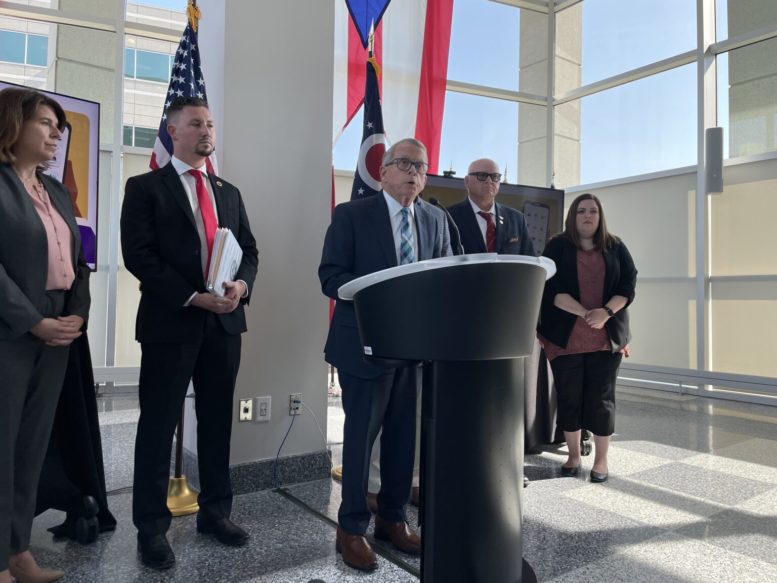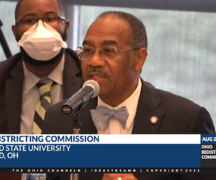BY JAKE ZUCKERMAN & NICK EVANS
Gov. Mike DeWine signed legislation Monday that could allow teachers to carry firearms in the classroom.
House Bill 99 grants local boards of education authority to decide whether to allow their teachers and school workers to carry firearms. Whether the bill establishes a quantitative legal minimum has been disputed. However, it says local school boards must require up to 24 hours of training from teachers before they can carry. Boards could choose to mandate more but this isn’t required.
Prior law coupled with a recent state Supreme Court ruling required teachers to complete 700 hours of training before carrying, effectively forbidding the practice. The new law takes effect 90 days from Monday.
“This is a local choice, not mandated by the legislature nor by the government,” DeWine said to reporters Monday. “Each school board will determine what is best for their students, their staff and their community.”
The Republican-backed bill passed the Ohio House in November. On the heels of the Uvalde shooting in May that left 19 young children and two teachers dead, Senate Republicans quickly passed the bill earlier this month and sent it to DeWine.
House sponsor, Rep. Thomas Hall, R-Madison Twp., drew a direct link from Uvalde while co-opting a slogan that emerged after a 2019 mass shooting in Dayton.
“After the horrific event that transpired in Uvalde, Texas, constituents and even many lawmakers were advocating for, and I quote, to ‘do something,’” Hall said. “I’m proud to be a part of this moment of, in fact, doing something that will without a doubt protect students and staff.”
Texas is one of 18 other states with a law allowing for armed teachers although few Texas educators have adopted the practice, according to the Texas Tribune.
The Ohio bill passed largely along party lines. Rep. Gayle Manning in the House and Sens. Matt Dolan and Stephanie Kunze were the only Republicans to vote with Democrats against it.
I don’t know why people keep thinking this is a game. These are families that lost their loved ones. I’m one of them that lost my loved ones, I was there that night, my father died right beside me.
– Dion Green, the son of a Dayton shooting victim, on HB 99.
Individual teachers, teachers’ unions, the Fraternal Order of Police, anti-gun violence activists and others opposed the legislation, arguing that insufficiently trained teachers are likely to harm students more than help in any active shooter situation.
Republicans, the gun lobby, and a select few school districts argued the legislation gives students a chance against a shooter, especially in rural school districts without resource officers on campus and a long drive away from any first responder.
Between the armed teachers bill and other related legislation, lawmakers also appropriated $117 million mostly as grants for schools to use for security upgrades. Researchers have cast doubt on the efficacy of both arming teachers and spending to “harden” schools in terms of limiting school shootings.
Exactly how much training the new law requires of teachers is somewhat unclear. It doesn’t explicitly state any minimum, although it lists several elements (first aid, response tactics, live firearms practice) the training must include. It says teachers would need to complete a “curriculum, instruction and training” that follows state requirements for private security guards, who must undergo 20 hours of training to carry a handgun.
Republicans said during floor debate the legislation requires 24 hours of training, which Democrats disputed. Nonpartisan legislative researchers who reviewed the bill didn’t note any minimum in their analysis. Lawyers who reviewed the legislation for the Ohio Capital Journal reached different conclusions on this point.
DeWine said Monday he would require the oversight body within the Department of Public Safety to require all 24 hours of training for any plan. He also insisted districts would be able to set additional training criteria so long as state officials approve the curriculum.
It’d be his “preference,” he said, that guns stay with school resource officers and not teachers, but the bill is about giving that choice to local school districts.
“In life, we make choices and we don’t always know what the outcome is going to be,” he said, when asked about the prospect of a teacher inadvertently shooting a student. “What this legislature has done and I’ve done by signing is giving schools an option based on their particular circumstances with the best decision they can make with the best information they have.”
The legislation doesn’t offer any specifics as to how teachers must store their firearms. It requires school boards to tell the public that one or more of its employees are armed but doesn’t require specifics as to who.
The armed teachers bill marks the latest in a series of significant deregulations surrounding firearms. Monday marked the first day of enactment for Ohio’s new permitless carry law, which allows those 21 and up who are legally allowed to possess a firearm to carry it concealed on their persons. Previous law required them to first obtain a license, which required eight hours of training and a background check.
Last year, DeWine signed a “stand your ground” bill as well. This removed a requirement from law that required a person to first seek to retreat before responding to a perceived attack with deadly force.
Do something
In August 2019, a young man killed 23 people and injured 23 others in a racially motivated mass shooting outside a WalMart in Texas. The next day, another young man killed nine and shot 17 more outside a bar in Dayton.
Soon thereafter, DeWine appeared in Dayton alongside then-Mayor Nan Whaley. DeWine’s speech was drowned out by protesters demanding someone “do something” to stop America’s second episode of mass slaughter in a single weekend.
Whaley, now running against DeWine as a Democrat, is seeking to channel this outrage into the November elections.
“For Mike DeWine, safety is just a campaign talking point,” she said during a news conference Monday. “He doesn’t actually give a s**t whether you or your family are safe.”
Several Republican lawmakers hijacked the post-Dayton phrase in floor speeches, characterizing their actions on House Bill 99 as “doing something.” Most Republicans emphasized that the bill doesn’t force school boards to arm their teachers, it merely gives them latitude to do so.
Whaley called that a ‘bastardization’ of what people in Dayton were demanding. Dion Green, whose father was killed in the Dayton shooting first learned that Republicans had co-opted the rallying cry of those pushing for reform at the press conference, and it didn’t sit well with him.
“Don’t play with words like that,” he said. “I don’t know why people keep thinking this is a game. These are families that lost their loved ones. I’m one of them that lost my loved ones, I was there that night, my father died right beside me.”
“For them to take that and turn it into something else differently,” he added, “that’s really a kick in the face.”
More headlines from Ohio Capital Journal:

Even according to its metrics, JobsOhio gets a middling grade
JobsOhio insists on grading itself according to its chosen criteria. But when it eventually shared parts of its own analysis, even that put Ohio in the middle of the pack relative to the six states JobsOhio compares itself to.
The economic-development agency has spent more than $1 billion since 2015, but last month it said that it’s not fair to judge it based on Ohio’s generally sluggish economy. Instead, it says it should be evaluated in the 10 sectors on which it chooses to focus.
However, even the partial analysis the agency shared last week shows that Ohio lost or didn’t gain market share in four of the 10 sectors between 2010 and 2020 when compared to West Virginia, Kentucky, Indiana, Michigan, Illinois and Pennsylvania. Between 2010 and 2019, Ohio lost market share in half of the sectors, a table shared by JobsOhio shows.






